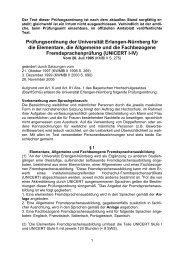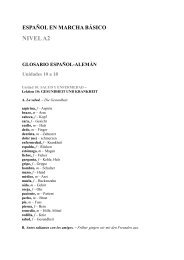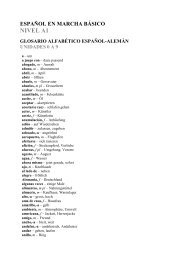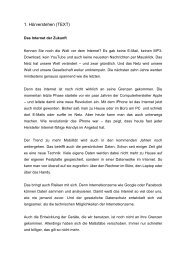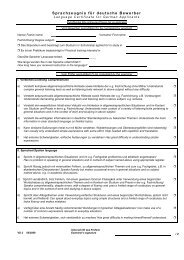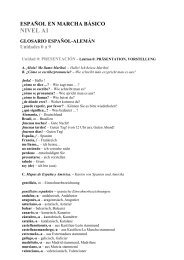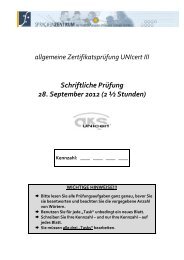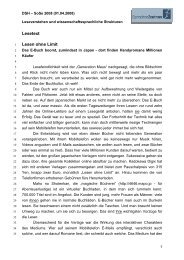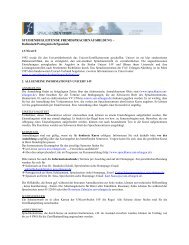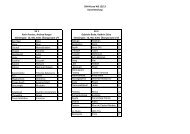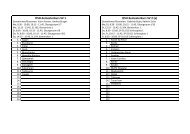UNIcert III exam WS12-13_allgemein.pdf
UNIcert III exam WS12-13_allgemein.pdf
UNIcert III exam WS12-13_allgemein.pdf
Erfolgreiche ePaper selbst erstellen
Machen Sie aus Ihren PDF Publikationen ein blätterbares Flipbook mit unserer einzigartigen Google optimierten e-Paper Software.
TASK 1: Reading Comprehension (GENERAL)<br />
(30 points)<br />
Read the following text then answer the questions in English in your own words.<br />
(Content: 15 points / language: 15 points)<br />
Maverick anthropologist's memoir sparks fresh row over ancient Yanomami tribe<br />
PAUL HARRIS THE OBSERVER, MARCH 2, 20<strong>13</strong><br />
5<br />
10<br />
15<br />
20<br />
25<br />
30<br />
Napoleon Chagnon provoked uproar with his account of life in an Amazon community. His<br />
latest work has reopened the debate<br />
It became one of the fiercest scientific arguments in recent times: are the Yanomami<br />
Indians of the Amazon rainforest a symbol of how to live in peace and harmony with nature<br />
or remnants of humanity's brutal early history?<br />
Now a debate that has divided anthropologists, journalists, human rights campaigners and<br />
even governments has been given a fresh burst of life by the publication of a lengthy<br />
memoir by outspoken US anthropologist Napoleon Chagnon.<br />
Chagnon has spent decades studying and living with the Yanomami (also known as the<br />
Yanomamö) and wrote the best-selling – and hugely controversial – Yanomamö: The Fierce<br />
People. In that book, which came out in 1968, he portrayed the 20,000-strong tribe, who<br />
live in isolated jungle homelands in Venezuela and Brazil, as a warlike group whose<br />
members fought and battled each other in near-constant duels and raids. He described<br />
Yanomami communities as prone to violence, with warriors who killed rivals far more likely<br />
to win wives and produce children.<br />
His analysis was criticised as a reductive presentation of human behaviour, seen as<br />
primarily driven by a desire to mate and eliminate rivals. Opponents of that view believed<br />
the Yanomami were still pursuing a lifestyle dating from mankind's early past, when people<br />
lived mostly peacefully in smaller communities, free from modern sources of stress and far<br />
more in equilibrium with their surroundings.<br />
Chagnon's new 500-page book, Noble Savages, is set to reignite the argument. In it he<br />
launches an impassioned defence both of his work and life among the Yanomami and an<br />
equally spirited attack on his critics and fellow scientists. The book's subtitle perhaps sums<br />
up his attitude to both groups: "My life among two dangerous tribes – the Yanomamö and<br />
the anthropologists."<br />
Chagnon describes life in the rainforest spent constructing villages, hunting for food, taking<br />
powerful hallucinogens and making bloody raids on rival groups. "The most inexplicable<br />
thing to me in all of this was that they were fighting over women... I anticipated scepticism<br />
when I reported this after I returned to my university," he wrote. He was not wrong. His<br />
research created a huge storm and accusations that it allowed Amazonian tribes to be<br />
depicted by governments and outside interests as bloodthirsty savages who deserved to<br />
lose their land to the developers.



